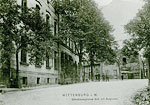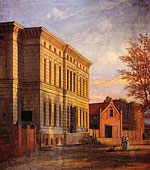A Museum with a Prospect
The site
There could scarcely be a finer setting for a museum: white, and visible for miles around, the FlourWorld Museum is set like a crown on Wittenburg’s Amtsberg Hill. The neo-classical building was erected in 1848 on the foundations of a medieval palace. And the palace, in turn, was built on the remains of a castle complex of Wendish (Slavic) origin.

From a Wendish castle to a royal widow’s residence
After the great migration of the peoples, between 400 and 600 A.D., the tribe of the Polabians settled in the area and built a Wendish castle on an artificial hill that is now the Amtsberg. Around 1150 the recapture of the Wendland by the superior forces of the Saxon duke Henry the Lion began, and the old castle was destroyed in the fierce fighting.
The site of the castle, cleverly chosen in the marshy flood plain of the river, formed a natural basis for a new fortress around which craftsmen settled and vigorous trade developed. The town of Wittenburg was founded as early as 1226, and the Amtsberg Hill may be regarded as its nucleus.
Around 1282, with the castle and massive fortifications around the centre of the town, Wittenburg developed into a notable location of the time. In the 16th century the palace on the Amtsberg Hill was the residence of the widowed duchess Anna Sophie, who held a protective hand over the citizens of Wittenburg and brought them prosperity with the establishment of smelting works and hammer mills for iron.
But in the centuries that followed the castle complex and palace gradually fell into decay. Only the gate tower, now lovingly restored, was able to survive the increasing ravages of time.



From a court building to a museum
The hill acquired its present appearance around the middle of the 19th century, when the imposing court building that still exists was built to serve the town and the surrounding area. The idyllic situation with a park and vegetable garden gave the site an unusual and charming atmosphere.
Until recently another imposing brick building from the same period, originally erected as a prison, stood at the entrance to the hill opposite the gate tower. Sadly, it became more and more dilapidated and had to be demolished in August 2006.
The court building itself was occupied from 1928 to 1944 by the judge of the time, Dr. Carl Tabel, his wife and seven children, and by the second judge – called Renn – and his wife. This “rennted” court building was rumoured to be profitable as well. After the war it was then used by the Soviet commandant’s headquarters for several years.
From 1950 the building served as a school: first as a vocational school, then from 1960 to 2004 as a primary school, and finally – until the summer of 2007 – as a branch of the local Christian Ludwig Liscow Grammar School.
By the way: Mühlenchemie’s production facility SternMaid is also located in Wittenburg.
